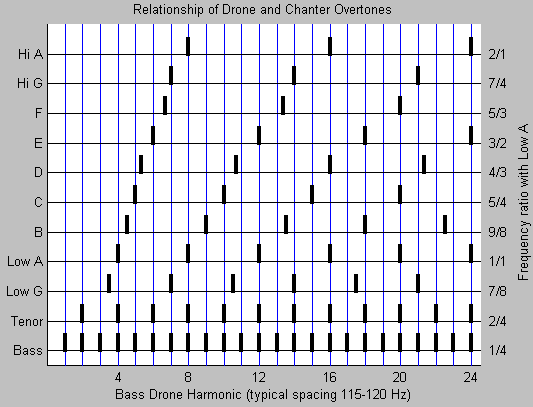
At Mon, 11 Jan 1999 06:04:38 GMT, pmlerwick@wavetech.net (Royce Lerwick) wrote:
The B is an interval that doesn't set itself, and it doesn't announce itself just by playing a drone against it for simple reasons of math.
Granted, if I play a low A and my buddy plays a B, it will sound quite nasty, although those Mysterious Bulgarians make liberal use of simultaneous major seconds and seem to be able to make them sound pretty good.
However, we are not talking about playing a chanter A and B together, but a chanter B with the much lower A of the drones two octaves down. Octave separation does matter. The same note in different octaves has some, but not all, of the same harmonic properties. Regular Just Intonation, Seumas MacNeill, and my measurements all agree that the B should/does lie at/near a frequency of 9/8 relative to low A, or 9/2 relative to the bass drone. First, consider a hypothetical high B, an extra octave up, above high A. This would be at a frequency 9 times that of the bass drone, and thus all of its harmonics would coincide with those of the drones. Ipso facto, no beats. For the real B, an octave down, every even harmonic coincides with one from the bass, as shown below. The odd harmonics fall exactly between the bass's, possibly producing "roughness", but too far away to generate audible beats. Thus, this B ought to be beat-free.

Have a listen, it is beat-free. Using my BABS (Barely Adequate Bagpipe Synthesis) program, I generated a wav file in which the B is played a few Hz below 9/8, then sweeps up to 9/8, stays there for 1 second, then sweeps up again. At 9/8 the beats vanish. There is not as well-defined a sweet spot as for A, C, or E, but it's certainly beat-less and with minimal "roughness".

Beats are most audible when the interacting overtones have the same level. This probably does not occur in practice, so I admit that the beating zones flanking the sweet spot may be difficult to hear in a real tuning situation.
Exactly the same argument applies to the trendy, super-low, "harmonic" low G at 7/8. A similar BABS example demonstrates that it is beat-free also. Have a listen.
Almost every chanter I have used has had a flat B, with no way to get up to the sweet spot without conducting some carving (for which I have lacked either the necessary permission or the intestinal fortitude). So I guess my B is usually floating around somewhere slightly into the lower rough zone. This appears to be the case also for several of the "Great Eight" from the Piping Centre 1996 Recital CDs. (I don't suppose this qualifies me for the "Fine Nine" ... :-) )
Other pages of potential interest
Ewan Macpherson, Jan 1999